The Neurological Implications of COVID-19: A Comprehensive Narrative Review
- PMID: 38887342
- PMCID: PMC11181960
- DOI: 10.7759/cureus.60376
The Neurological Implications of COVID-19: A Comprehensive Narrative Review
Abstract
The COVID-19 pandemic caused by the coronavirus SARS-CoV-2 revealed a huge number of problems as well as discoveries in medicine, notably, regarding the effects of the virus on the central nervous system (CNS) and peripheral nervous system (PNS). This paper is a narrative review that takes a deep dive into the complex interactions between COVID-19 and the NS. Therefore, this paper explains the broad range of neurological manifestations and neurodegenerative diseases caused by the virus. It carefully considers the routes through which SARS-CoV-2 reaches the NS, including the olfactory system and of course, the hematogenous route, which are also covered when discussing the virus's direct and indirect mechanisms of neuropathogenesis. Besides neurological pathologies such as stroke, encephalitis, Guillain-Barré syndrome, Parkinson's disease, and multiple sclerosis, the focus area is also given to the challenges of making diagnosis, treatment, and management of these conditions during the pandemic. The review also examines the strategic and interventional approaches utilized to prevent these disorders, as well as the ACE2 receptors implicated in the mediation of neurological effects caused by COVID-19. This detailed overview, which combines research outputs with case data, is directed at tackling this pandemic challenge, with a view toward better patient care and outcomes in the future.
Keywords: covid-19; encephalitis; guillain-barre syndrome; neuroimmunology; neuroinvasion; neurological complications; neuropathogenesis; parkinson's disease; sars-cov-2; treatment strategies.
Copyright © 2024, Cheyne et al.
Conflict of interest statement
The authors have declared that no competing interests exist.
Figures



References
Publication types
LinkOut - more resources
Full Text Sources
Miscellaneous
